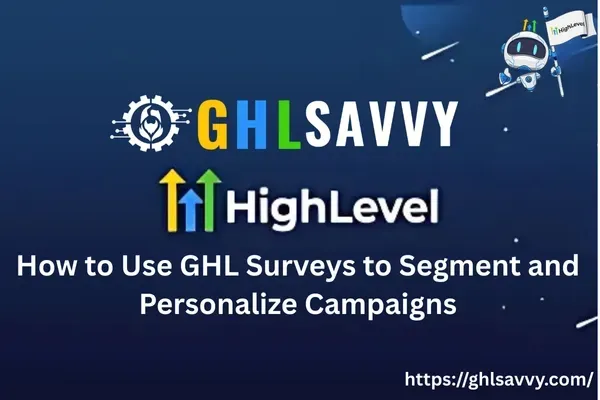
GHL Surveys
How to Use GHL Surveys to Segment and Personalize Campaigns
Table of Contents
Introduction
Why Personalization Matters in Modern Marketing
What Are GHL Surveys?
The Psychology Behind Surveys for Engagement
Step 1: Setting Up GHL Surveys for Your Agency
Step 2: Segmenting Leads With Survey Responses
Step 3: Using Survey Data to Personalize Campaigns
Case Study: Agency Boosting Conversions With GHL Surveys
Advanced Strategies (Branching Logic, Automations, & More)
Common Mistakes to Avoid
Final Thoughts
Introduction
In 2025, customer expectations have shifted people no longer want generic campaigns or cookie-cutter marketing. They expect personalized experiences, tailored messaging, and offers that speak directly to their pain points.
This is where GHL surveys come in. More than just a data collection tool, they are a powerful way to segment your audience and personalize campaigns inside GoHighLevel. Done right, they transform casual leads into engaged prospects and loyal clients.
Why Personalization Matters in Modern Marketing
Generic messages no longer cut it. Studies show that:
80% of consumers are more likely to buy from brands that offer personalized experiences.
Personalized emails deliver 6x higher transaction rates.
Segmented campaigns result in over 40% more conversions compared to broad campaigns.
By using GHL surveys, agencies and local businesses can gather valuable insights and segment leads based on:
Interests
Budget
Buying timeline
Pain points
Preferred communication channels
What Are GHL Surveys?
GHL surveys are interactive forms built directly inside GoHighLevel that:
Capture lead insights beyond just name and email.
Allow you to ask targeted questions (multiple choice, open-ended, ratings, etc.).
Sync automatically with your CRM to trigger automations.
Work seamlessly with funnels, websites, and landing pages.
Think of them as a personalization engine: every answer tells you how to guide the next step in the client journey.
The Psychology Behind Surveys for Engagement
Surveys don’t just gather data—they create a two-way interaction. This triggers:
Commitment bias: Once a lead engages with a survey, they’re more likely to continue engaging.
Personal relevance: When questions feel relevant, people assume the campaign will be more valuable.
Trust building: Asking questions shows you care about their needs, not just their wallet.
Step 1: Setting Up GHL Surveys for Your Agency
Here’s how to build your first survey:
Go to the Sites → Surveys section in GoHighLevel.
Choose question types (multiple choice for easy segmentation, open-text for insights).
Add conditional logic if you want dynamic pathways.
Embed your survey in a landing page or send it via email/SMS.
Pro tip: Keep it short—5 to 7 questions max. Long surveys reduce completion rates.
Step 2: Segmenting Leads With Survey Responses
Once responses are collected, you can:
Tag leads (e.g., “Budget: $500–$1,000” or “Interested in Coaching”).
Assign leads to different pipelines.
Score leads based on urgency or buying potential.
Use responses to trigger different nurture sequences.
Example:
If a lead says their budget is low → send them a DIY solution funnel.
If they say they’re ready to buy → send them directly to a booking link.
Step 3: Using Survey Data to Personalize Campaigns
Here’s how survey insights can supercharge campaigns:
Emails: Personalized subject lines (“John, ready to scale your gym this month?”).
SMS: Send offers based on specific service interest.
Funnels: Redirect survey takers to unique landing pages.
Ads: Create custom audiences in Facebook/Google based on survey data.
Case Study: Agency Boosting Conversions With GHL Surveys
A fitness marketing agency used GHL surveys to segment gym leads.
Survey questions included:
“How many members does your gym currently have?”
“What’s your biggest growth challenge?”
Results:
Leads struggling with retention received retention-focused emails.
Leads struggling with new sign-ups received a “30-day challenge funnel.”
Outcome:
Conversions increased by 37%.
Churn decreased because clients felt their problems were directly addressed.
Advanced Strategies (Branching Logic, Automations, & More)
Branching Logic: Show different follow-up questions based on previous answers.
Automation Triggers: If someone chooses “budget $5,000+,” instantly alert your sales team.
Cross-Selling: Use surveys post-purchase to identify upsell opportunities.
Feedback Loops: Send surveys to existing clients for NPS (Net Promoter Score).
Common Mistakes to Avoid
Asking too many questions → Shorter = higher completion.
Not connecting surveys to automations → Data without action is wasted.
Using vague questions → Always ask clear, business-relevant questions.
Not analyzing results → Check trends monthly and refine campaigns.
Final Thoughts
GHL surveys are more than forms they are conversion engines. By strategically segmenting leads and tailoring campaigns, you can:
Improve lead quality
Boost engagement rates
Deliver highly personalized experiences
Convert faster with less ad spend
If your agency or local business wants to stand out in 2025, mastering GHL surveys is no longer optional it’s the foundation of personalization-driven marketing.